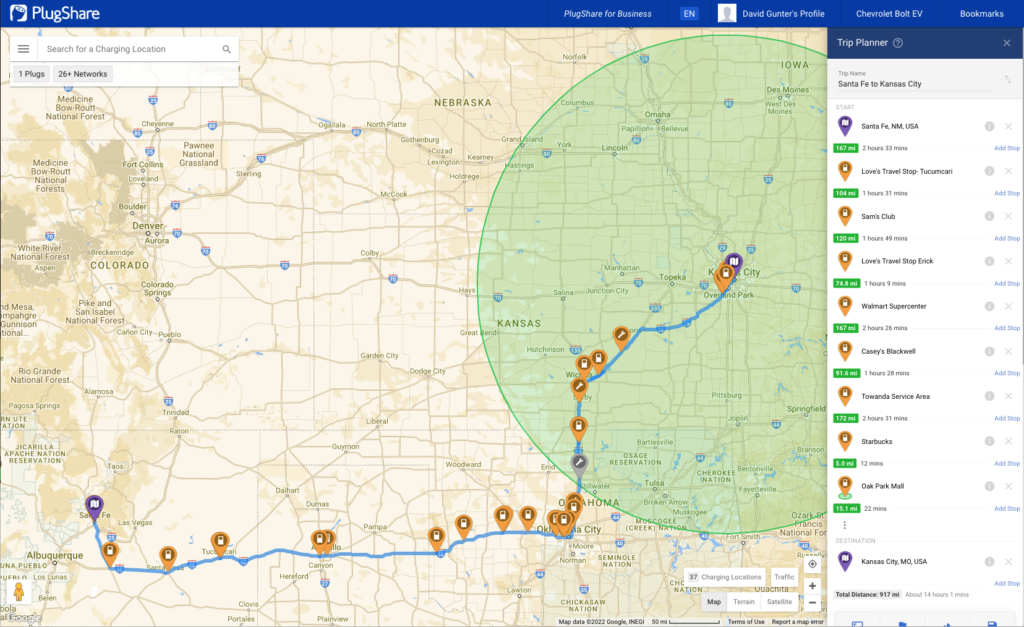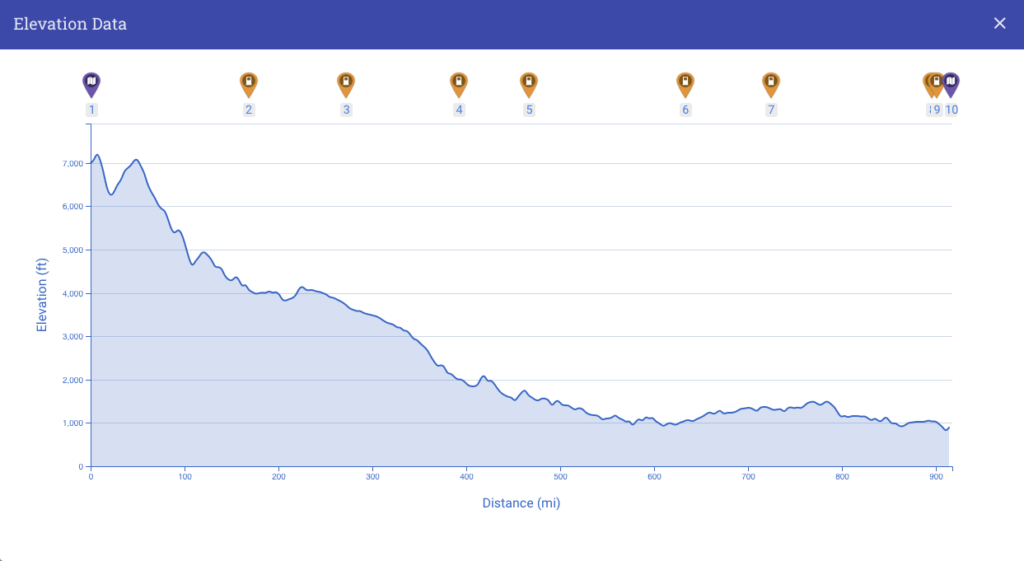A Cross-Country Trip In The Chevy Bolt EV
I recently made my first and perhaps only long distance cross-country trip in my Chevy Bolt. You see, when I purchased the Bolt in 2019 it was with the idea that it would primarily be my daily commuter car. The round-trip distance to my office is 100 miles and a low-cost EV with a range of 238 miles seemed ideal. Furthermore, we had gone solar back in 2015 and sized our system for an eventual electric vehicle. Thus a commuter car for which I didn’t have to pay for fuel was a no-brainer and the vehicle has excelled in that role. Besides, at that time there were no networks of fast charging stations that would allow me to leave the state of New Mexico, let alone drive all the way across the country.
Cut to now, a few years later in mid-2022. Fast charging networks seemed to have sprouted like weeds on the landscape. It is finally possible to drive, at least along all the major interstates, anywhere in the country without fear that you couldn’t make it from one charging station to the next. The desire to make such a trip has been steadily building up. A trip back home to visit family seemed to be the ideal time to give it a shot.
I had a few reasons for making this trip. For starters, I was simply curious. What is it like to travel long distances that require longer-than-average stopping times along the way? Secondly, how reliable is the charging infrastructure, especially for us non-Tesla drivers? As for the Bolt, how accurate was the advertised range of 238 miles when driving at highway speeds in 100ºF temperatures with the AC running? I also had one major reason for not taking the trip–charging time. In order to keep costs down, the Chevy Bolt was designed with a maximum DC charging rate of about 55 kW. We’ll get into the specifics later but this meant that for each planned stop to charge I was looking at least an hour or more. Of course, I had to see this for myself in action. The trip was on.
Chevy Bolt Specs
The Bolt has a 66 kWh battery that gives it an estimated range of 250 miles.* Although the range is pretty decent, the charging rate is limited by design to about 55 kW. Ideally this would mean that charging from empty to 100% would take 66 kWh/55 kW = 1.2 hours. This is already pretty slow compared to the 5 minutes it would take to fill up a traditional tank with gasoline but this ideal rate isn’t what happens in practice. As a battery charges, it takes more effort to continue to add additional charge as it becomes full. Without getting into a detailed discussion of materials characteristics, degradation mechanisms, thermal runaway characteristics, and a host of other engineering aspects of battery design, think of this as trying to fill a large balloon full of water and as the balloon expands, the counter force of the water trying to squeeze out makes it harder to put more water in.
Charging systems have been designed to charge the battery at a constant voltage, ramping up the current to achieve the best power level for a given charging state. The Chevy Bolt engineers took a fairly conservative stance. The LG battery module can handle up to 65 kW of power but they settled on a maximum around 55 kW. Then starting at the 50% charge level the voltage and overall power are gradually reduced per the reasons stated in the previous paragraph. The graph below shows the curve for charging a 2017 Bolt from 0% to 100%.*

Not shown by the graph is the time it takes to charge and this is where the Bolt pales in comparison to newer EVs on the road. No matter what fast DC charging station one pulls into, assuming it is rated at 50kW or higher, the Bolt will only charge at 55kW and then taper down once the charge level reaches 50%. For me, this meant that charging from 5% to 80% took at least 1-1/2 hours. Fortunately, most of my stops involved going from 20-25% to 80% which completed in about an hour. Still painfully slow.
*All Chevy Bolts prior to 2022 models are receiving a new battery pack due to the known fire hazard recall. This upgrades the battery from the original 60 kWh to 66 kWh and extends the range to 250 miles. In addition, the charging rate graph shown for the 2017 model will also be that of newer models. I received my new battery module in March of 2022.
Route Planning
Planning for this trip seemed to involve the same amount of effort as filing a flight plan to fly a Cessna cross country. My go-to site for this was PlugShare, a well-known source of available charging stations throughout the world that is maintained largely by its users. Just about every known charging location is listed on the site with new ones popping up weekly. They list everything from available 120V outlets to the fastest DC charging stations out there. EV drivers can check-in to these stations and leave reviews and comments about them as they do. In this way, the next driver to come along has a good idea if the station is working or not, or how well it may be working. The website is an open-source, constantly updated compendium of EV charging options.
The site is built around the Google Maps API and is easy to navigate. A filtering tool lets one choose what types of charging stations to see. I set it to only show fast DC charging stations, with the exclusion of Tesla-centric ones. I was surprised at how populated the map was after refreshing.
The map below shows my outgoing route. It lists the charging stations I selected along the route, basically I-40 across New Mexico, Texas, and Oklahoma, and then I-35 up through Kansas and into Missouri. The large green circle represents a maximum radius search along my route for finding the next charging station. I set this to 190 miles, the maximum distance I can expect to travel if starting from 80% charge. Why 80%? Because in order to decrease the amount of time spent charging and traveling, I wanted to stop each charging session at 80%. Ideally I would create even shorter charging stops if I stopped at 50% but there are simply too many gaps between available chargers where the distances involved wouldn’t get me there on 50%. Also, traveling on 50% battery would mean stopping far more frequently than I would like. 80% charge seems to be the good balance.

Not shown on the route are backup charging stations I listed “just in case”. I had a print out of all my main stops plus others within a reachable driving distance just in case one didn’t work out. The reason for the printed copy was in case I found myself suddenly without a cellphone signal or any other phone malfunction. I did not want to find myself out of power in the middle of nowhere.
The next graph shows the elevation change from Santa Fe to Kansas City. I went from 7,000 ft at home to 1,000 ft in KC. I expected that I would see better performance on the way there than on the way back because of this but it didn’t seem to make any difference.

The Trip
The tables below present the raw data gathered during each charging stop for each leg and then one showing the overall totals. My driving speed was the speed limit + 5 mph set on cruise control, AC used as needed. These are 75 mph highways for the most part. There is some additional explaining to do.
On the outbound trip, I got a late start (6:30 AM MDT). I was hoping to get most of my driving underway in the early morning to avoid using the AC so much. I did average around 3.3 mi/kWh until my first stop in Tucumcari, NM, by which time it was already 85ºF outside. As it turns out, running the AC didn’t degrade the efficiency as much as I thought it would.
Also at my first stop I encountered a problem that many Bolt owners have run into. There is a problem with the Bolt’s charge port wherein a metal latch piece that clamps down on the charging handle to prevent its removal would sometimes not engage. It took me an hour to figure out how to initiate a charge session by holding the piece down with a screwdriver until the charge initiated and the latch locked in place. The fix for this (done after I charged) was to disconnect the 12V battery for 30 seconds and then reconnect it. That actually worked and I haven’t run into this problem again. However, I hope Chevy fixes this issue. My first stop was around 02:20 and put me in a mood.
At a few of my stops I tended to charge up to 85% and one to 92% hoping that I could push the distance and skip one of the planned stops. This turned out to be a useless effort that only cost me more charging time but which didn’t give me the extra distance I wanted. By the time I got to Oklahoma, it was getting late in the day. I made a stop in Blackwell, OK, at 10 PM CDT and decided that was where I’d stop for the night. There was a bank of Francis Energy fast DC chargers in front of the SureStay hotel I ended up checking into, so this allowed me to charge up to 100% and be ready to go the next morning.
I hadn’t realized just how many of these stops would be at Electrify America stations, the network Volkswagen has been developing as it pursues its EV agenda. I was on their basic free account at a rate of $0.42/kWh. After arriving in KC I read about their $4/month plan, where you only get charged $0.31/kWh. There is no commitment beyond a month so you can switch back to the free plan at any time. I signed up and paid the $4 for the return trip and that is one of the reasons my costs on that segment were so much less. It was well worth the extra $4.
For the return trip I had improved my strategy from what I learned on the way out. There was one “danger zone” of sorts between KC and my first stop in Towanda, an oasis along the Kansas Turnpike. There were no charging options between these two locations, a distance of 181 miles. I pulled into the stop with just under 5% of my charge remaining. To make sure I had enough to get through northern Oklahoma, I spent 2 hours charging at this location. The travel center had free wifi and tables with outlets, so I was able to get some work done while waiting. Every stop from that point onward, however, was kept just long enough to reach a charge level that would get me to the next stop, around 40-50 minutes. The exception was when I crossed back into New Mexico. I charged up extra in Tucumcari because one of my stops, Clines Corners, about 60 miles from home, was a new station that had mixed reviews. Some reported it didn’t work, some that it did. I needed to charge extra at Tucumcari to add extra mileage to make it to Albuquerque, the next stop after Clines Corners, just in case. But then I threw in a last minute stop to Santa Rosa, NM, to add even more miles so that if Clines Corners didn’t pan out, I could still get home. Finally, I reached Clines Corners and their new 25kW Max stations were live and working, so I spend 20 minutes there just to make sure I could easily finish the last 60 miles.
My change in strategy for the return trip meant that I shaved about 2 hours off the overall trip even though the actual driving time was about the same. I spent an hour less charging and saved about $41. The cost savings was from signing up for the cheaper Electrify America plan, as well as by not trying to charge above 80% and spending extra money on the few stations that had a cost per minute fee in addition to the kWh fee. This also meant that the average charging rate was higher on the return trip.
Finally, even though I was constantly gaining altitude I managed to achieve a 3.38 mi/kWh efficiency on the return trip versus 3.21 mi/kWh on the outbound trip. I don’t quite know why this was the case but one data point to consider is that on my way out, much of Texas, Oklahoma, and Kansas was above 100ºF. On the return trip, major storms had passed through the area and the highest temperature I encountered was late in the day in Amarillo, where it was 88ºF.
Santa Fe to Kansas City
| Mile | From Previous Stop | Charging Time | kWh Added | Avg. Charging Rate (kW) | Cost |
| 175.4 | 175.4 | 1:17:28 | 45 | 34.85 | $20.97 |
| 279.8 | 104.4 | 1:15:22 | 38 | 30.25 | $12.98 |
| 400.0 | 120.2 | 00:55:10 | 30 | 32.63 | $14.17 |
| 474.5 | 74.5 | 1:08:31 | 32 | 28.02 | $15.07 |
| 572.4 | 97.9 | 00:39:49 | 24.9 | 37.46 | $16.52 |
| 656.5 | 84.1 | 1:51:13 | 46.6 | 25.14 | $44.37 |
| 734.7 | 78.2 | 1:02:00 | 23 | 22.27 | $3.73 |
| 890.7 | 156 | 1:28:00 | 46.2 | 31.50 | $0 |
| 918.1 | 27.4 | - | - | - | - |
Kansas City to Santa Fe
| Mile | From Previous Stop | Charging Time | kWh Added | Avg. Charging Rate (kW) | Cost |
| 181.6 | 181.6 | 2:02:20 | 60.7 | 29.77 | $9.81 |
| 259.8 | 78.2 | 0:42:00 | 18 | 25.71 | $5.58 |
| 343.7 | 83.9 | 0:38:51 | 24 | 37.10 | $16.15 |
| 430.2 | 86.5 | 0:48:00 | 30 | 37.50 | $9.30 |
| 505.2 | 75.0 | 0:53:48 | 29 | 32.34 | $9.88 |
| 626.7 | 121.5 | 0:52:00 | 36 | 41.54 | $6.26 |
| 731.2 | 104.5 | 1:12:17 | 44 | 36.52 | $14.78 |
| 788.4 | 57.2 | 0:34:10 | 18 | 31.61 | $6.05 |
| 847.9 | 59.5 | 0:19:52 | 8.6 | 25.97 | $8.74 |
| 908.2 | 60.3 | - | - | - | - |
Trip Totals
| Elapsed Time | Driving Hours | Charging Time | kWh Added | Cost | Cost/kWh | Avg. mi/kWh | Avg. Charging Rate (kW) |
| 23:04:00 | 13:26:27 | 9:37:33 | 285.67 | $127.81 | $0.45 | 3.21 | 29.68 |
| 21:19:00 | 13:15:42 | 8:03:18 | 268.32 | $86.55 | $0.32 | 3.38 | 33.31 |
Conclusions
I enjoyed the trip and was glad to spend time with my family. It was a fun adventure in figuring out how traveling with an EV works and what to expect. I don’t think I will ever do it again with this vehicle, though; the charging rates are simply too slow. I saw two vehicles during my travel stops that are much better suited to this type of travel, and more are due out on the market in the coming years. At one stop, a Polestar 2 pulled up to charge next to me. It is a nice looking car and the owner gave me the full rundown on it while it was charging. It is certainly more luxurious than I need but the most impressive thing was how the car went from 5% to 80% charge in about 19 minutes, and then the driver was off. It has a maximum charging rate of around 196 kW, about 4x faster than the Bolt. I also spotted a Kia EV6 that was in and out pretty fast at one of my stops. That car is built on an 800V platform that is ridiculously fast. I think the charging rate I witnessed was bout 250 kW. So don’t let my story here turn you off if you’ve been thinking of purchasing an EV; there are great ones out there for making long distance trips.
Comparisons to ICE Vehicle
I drove a total of 1,826.3 miles and spent $214.36 on electricity. With gas at more or less $4.70 everywhere I drove, this would be the equivalent of 45.6 gallons purchased. To go that distance would require a 40 mpg car, something I think a few hybrids are able to do (my previous Chevy Volt being one of them). So it is comparable in cost to regular car travel with a few caveats. One, I’ll never need an oil change or other similar maintenance. Tires at about 65K miles is about it. Even the brake pads should last 200K miles thanks to regenerative breaking. Two, by signing up for EA’s cheaper plan, I would have spent a lot less at electricity, which makes the EV the cheaper option.


Recent Comments